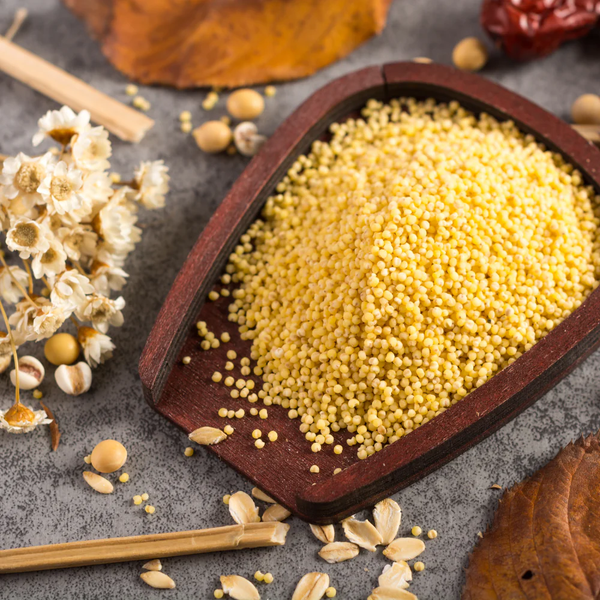Kodo Millet: Tiny Grain, Mighty Benefits (and How to Cook It)
If grains had personalities, Kodo millet would be that quiet achiever in the back of your pantry – humble in appearance, yet full of surprises. This ancient grain is finally having its moment in the spotlight (about time!) for all the right reasons. In this Wise Mama guide, we’ll explore what in the world is Kodo millet, how to cook Kodo millet into delicious meals (hello, khichidi MVP!), its stellar nutrition profile, and even who might want to skip a second helping. So grab a comfy seat and let’s dive into the quirky world of Kodo millet with a wink and a smile!

A close-up of Kodo millet grains (dehusked) – small, ivory-colored pearls that pack a nutritional punch.
What in the World is Kodo Millet?
Kodo millet is a small, nutrient-dense grain that has been cultivated for thousands of years. It goes by many names across India – in Hindi it’s often called “Kodo” or “Kodon”, and in Tamil you’ll hear it referred to as “Varagu”. (Bonus points: Impress your friends by dropping these regional names at the next dinner party!) Botanically, it’s a type of millet (scientific name Paspalum scrobiculatum), and like its millet cousins, it’s naturally gluten-free and belongs to the grass family. Don’t confuse it with quinoa or rice – although it’s about the size of a poppy seed, this grain has its own unique identity.
Origin and Grown In: Wondering where Kodo millet is grown in India and beyond? Originally believed to have come from Africa, Kodo millet has been grown in India for at least 3,000 years. Today, India produces the lion’s share of the world’s Kodo millet (around 90%!) and the grain is cultivated in several states including Gujarat, Karnataka, Tamil Nadu, Maharashtra, Odisha, West Bengal, Rajasthan, and Uttar Pradesh. It’s a hardy crop that thrives in drought-prone, rain-fed areas where other crops struggle. In other words, Kodo millet is the tough survivor of the agricultural world – it laughs in the face of poor soil and low water, making it an eco-friendly choice too.
Which is Kodo Millet, again? If you’re staring at a sack of mixed millets and scratching your head, Kodo millet is the one with tiny, pale brown or light cream grains (once the husk is removed) that look a bit like mini sesame seeds. It might not look like much, but as we’re about to see, it’s what’s inside those counts.
Kodo Millet Nutrition: Tiny Grain, Big Benefits
Time to talk nutrition – because this little grain is loaded. In fact, Kodo millet is often dubbed a “nutritional powerhouse. What is Kodo millet rich in? For starters, fiber and protein are two of its standout components, making it a darling of dieticians. Kodo millet is rich in fiber, protein, B vitamins, and essential minerals like iron, magnesium, and calcium. (Who knew something so small could carry so much good stuff?) It also has complex carbohydrates that release energy slowly – no sugar spikes here, thank you very much.
Let’s break down some of the key health benefits and claims swirling around this grain:
- Gentle on Blood Sugar (Diabetes-Friendly): Kodo millet has a low glycemic index, meaning it releases glucose slowly into the bloodstream. In plain speak: it’s less likely to cause those wild blood sugar spikes that white rice might. Research even suggests it can help manage type 2 diabetes. In fact, Kodo millet is good for diabetes – it’s low in sugar and high in polyphenols that help reduce blood glucose levels. One study in 2022 found that Kodo millet-based foods (like Kodo idli and upma) had about 60% lower glycemic index compared to their rice-based counterparts. Diabetics, rejoice – your grain options just got wider.
- Weight Loss Ally: If you’re considering Kodo millet for weight loss, you’re onto something. Its high fiber content keeps you full longer and can help curb overeating. Plus, it’s relatively low in calories for the volume it provides once cooked (high volume, high satiety). Research on Kodo millet shows it’s rich in polyphenols that may help prevent obesity. In other words, this millet isn’t just figuratively slimming – it literally helps keep you slim by keeping those cravings in check. It’s like your secret weapon against midnight snack attacks: a bowl of Kodo millet can fill you up and tell your brain “I’m satisfied” for hours. Talk about tiny but mighty!
- Digestive Health & Detox: All that fiber (nearly 3 times more fiber than rice or wheat according to some studies) means Kodo millet is a boon for your digestive system. It aids in regular bowel movements (yes, we’re going there – Wise Mama cares about your gut!). It’s also rich in antioxidants and flavonoids which act as natural detoxifiers. Kodo has even been traditionally regarded as a “blood purifier” that can help remove toxins from the body. While we can’t promise it will make you as pure as a monk, it certainly won’t hurt!
- Heart Health: Your heart appreciates Kodo millet’s low fat, high fiber combo. The grain contains beneficial phytochemicals like phytic acid which is known to help lower cholesterol. It’s also a good source of magnesium – and fun fact: Kodo millet boasts one of the highest magnesium contents among all millets. Magnesium helps relax blood vessels and can keep blood pressure in check. Add potassium (present in moderate amounts) into the mix, and you have a recipe for a heart-healthy grain. Essentially, Kodo millet is like a tiny cardio coach that whispers “be well” to your heart and blood vessels.
- Kidney-Friendly: Usually, if you have kidney issues you have to be careful with certain grains due to potassium or phosphorus content. Here’s some good news – Kodo millet can be a helpful addition for kidney patients in moderation. Thanks to its lower potassium levels compared to many other staples, plus high fiber and lower uric acid production, Kodo millet is considered a helpful aid for kidney disorders. It even contains compounds that may reduce the risk of kidney stone formation. Of course, if you have serious kidney disease, always follow your doctor’s diet advice. But broadly speaking, this millet doesn’t overload the kidneys like some other foods might. In fact, some call it a nephrologist-approved grain (okay, that’s Wise Mama’s exaggeration, but you get the point).
- Packed with Vitamins & Minerals: Let’s not forget the basics – Kodo millet is rich in B-complex vitamins (niacin, B6, folic acid – the gang’s all here) and minerals such as iron and zinc. Iron helps keep your energy levels up and fights anemia (especially helpful for women), while B vitamins support metabolism and overall vitality. There’s also a neat component called lecithin in Kodo millet (especially high compared to other grains) which is great for your nervous system and brain health. So you can literally call Kodo a “brain food” without irony.
In summary, this unassuming grain is like a multivitamin in cereal form. From managing diabetes and weight to supporting heart, kidney, and gut health, Kodo millet’s benefits make it much more than just an old-school staple. No wonder millets in general are experiencing a renaissance among health enthusiasts!
Is Kodo Millet the Real Khichidi MVP?
We Indians love our khichidi – that one-pot comfort food made of rice and lentils (dal) which cures everything from hunger pangs to heartbreaks. But what if we told you the real MVP (Most Valuable Player) of khichdi might actually be Kodo millet? Gasp! Okay, that might be a bit dramatic, but hear me out.
Kodo millet makes an excellent rice substitute in your beloved khichdi, upping both the nutrition and the flavor. In fact, a Kodo millet khichdi could easily steal the show at your next family lunch. The millet’s slightly nutty, earthy taste pairs beautifully with the warmth of spices and the creaminess of lentils. Is your mouth watering yet? Let’s talk about how to make it happen.
How to Make Kodo Millet Khichidi (Recipe in a Nutshell)
Making Kodo millet khichidi is as easy as making the traditional version – it just swaps out the grain:
- Rinse and Soak: Always start by washing Kodo millet thoroughly. Wise Mama tip – soak it for at least 30 minutes (or up to 6 hours if you remember ahead of time) before cooking. Soaking helps reduce cooking time and improves digestibility (less chance of bloating). Traditionally, folks soak millets to neutralize some of the phytic acid and make nutrients more absorbable.
- Ingredients: For a simple khichidi, you’ll need Kodo millet and split yellow moong dal (typically in a 2:1 ratio like 1 cup millet to 1/2 cup dal). Throw in whatever veggies you fancy – chopped carrots, peas, beans, tomatoes – khichidi is very forgiving. And don’t forget the aromatics: a bit of cumin seeds, ginger, maybe a bay leaf or a pinch of asafoetida (hing) for that extra kick.
- Cook: In a pressure cooker (the desi MVP of kitchens) or a pot, heat a spoon of ghee or oil. Sauté cumin, ginger, and veggies, then add the drained millet and dal. Stir for a minute, add turmeric, salt, and about 3 cups of water for every cup of millet (adjust for your desired consistency). If using a pressure cooker, how to cook Kodo millet in a pressure cooker for khichdi is straightforward: close the lid and cook for about 2 whistles on medium flame (approximately 8-10 minutes). On the stovetop, bring to a boil then simmer covered until everything is soft and porridge-like, about 15-20 minutes.
- Enjoy: Once it’s done, let the pressure release, give it a good mix (it should have a risotto or porridge consistency), and garnish with fresh coriander. Serve hot with a squeeze of lemon and maybe a dollop of yogurt on the side. Congratulations, you’ve made a hearty, healthy khichidi starring Kodo millet! Is Kodo millet the real khichidi MVP? Take a bite and decide for yourself.

A comforting bowl of Kodo millet khichdi – a one-pot dish made with Kodo millet, lentils, veggies, and spices. It’s like the hug of Indian comfort foods, only healthier!
But khichidi is just one star performance for this grain. There are countless fun ways to use Kodo millet:
- Kodo Millet “Rice”: The simplest way to eat it – cook it just like you would cook rice. How to make Kodo millet rice? Easy: use a 1:2.5 ratio of millet to water, simmer until tender (about 15-20 minutes). Fluff it up and you have a bowl of Kodo millet rice ready to accompany curries, stir-fries or dals. You can even toss cooked Kodo millet into salads in place of quinoa for a desi twist.
- Upma and Pongal: Kodo millet works great in traditional breakfast dishes. Make a millet upma by toasting it lightly and cooking with tempering of mustard seeds, curry leaves, veggies, and nuts. Or try a Ven Pongal with Kodo millet and moong dal – your taste buds won’t miss rice at all, promise.
- Idli & Dosa Batter: Yes, you can sneak Kodo millet into your South Indian idli/dosa routine. Replace rice with Kodo millet (either partially or fully) in your batter recipe. The result? Soft, fluffy Kodo millet idlis and crisp dosas that are higher in fiber and nutrients. They have a slight golden hue and a subtle rustic flavor – perfect with coconut chutney. (Wise Mama experimented with Kodo idlis last Sunday – family approved!)

Steamed Kodo millet idlis – they might look a tad more rustic than rice idlis, but they are fluffy, light, and perfect for a healthy breakfast.
- Pulao, Biryani and Beyond: Feeling fancy? Use Kodo millet in place of rice for pulao or biryani. It absorbs flavors well. Imagine a millet biryani with spices, veggies, maybe some paneer or chicken – guilt-free second helpings for all! For a simpler take, make a fried “rice” with cooked Kodo millet, soy sauce, and veggies – an Indo-Chinese millet mashup.
- Porridge or Ambali: Cook Kodo millet with milk or water to make a porridge. Sweeten it with jaggery or honey, top with nuts and fruits. It’s a nourishing breakfast. In some regions, a fermented gruel called ambali is made with millets like Kodo – it’s an acquired taste but superb for gut health.
- Baking and Snacks: You can even mill Kodo millet into flour and use it partly in baking recipes – think millet muffins or rotis. Millet flour chapatis (mixing Kodo millet flour with wheat or other flours) are a great way to add nutrition. Also, puffed Kodo millet snacks and energy bars are now popping up in health stores. Truly, how to use Kodo millet is only limited by your creativity.
To sum it up, you can eat Kodo millet for breakfast, lunch, dinner or snacks – it’s one versatile grain. From khichidi to cookies, this millet does it all. And if you’re new to millets, Kodo is actually a great one to start with; experts often suggest starting with these smaller millets because they’re easier to cook and digest for newbies.
When and How to Eat Kodo Millet (Wise Mama’s Tips)
You might be thinking, “Alright, I’m convinced to try it – but when to eat Kodo millet? And can I eat it every day?” Great questions. Here are some practical tips to make the most of this super grain, Wise Mama style:
- Anytime is Millet Time: There’s really no wrong time to enjoy Kodo millet. It can fit into any meal. Have it as a porridge or idli for breakfast (it’s actually a top breakfast choice since it keeps you full and energized), a salad or khichdi for lunch, or as a light millet rice bowl for dinner. Because it’s quite filling, many people find millet dinners help prevent late-night snacking. And remember, Kodo millet is considered a cooling grain, so it’s especially great in summer months or warmer climates. (Looking at you, tropical weather!)
- Kodo Millet: Heat or Cold? In Ayurvedic and traditional terms, foods are often classified as “heating” or “cooling” to the body. So, is Kodo millet heat or cold? Kodo millet is generally thought to be neutral to slightly cooling in effect. That makes it an excellent choice for keeping the body balanced in hot weather. In fact, nutritionists list Kodo among millets ideal for summer diets. Contrast that with “heating” millets like ragi or bajra which are better in winters. So if you’re sweating in the Indian summer, a Kodo millet salad or ambali might just soothe you from the inside out.
- Moderation is Key: Now, about that “can we eat Kodo millet daily” question – technically, yes you can eat it every day since it’s a wholesome food. But do you need to? Not really. Wise Mama’s advice (and general consensus) is to rotate your grains through the week. Millets are fantastic, but variety is the spice of life (and of nutrition). Eating Kodo millet daily in large quantities could, for some people, lead to minor digestion discomfort because of the high fiber. Ideally, enjoy Kodo millet 3-4 times a week and mix it up with other millets, rice, wheat, etc. That way, you get a broader spectrum of nutrients and avoid overloading on any one thing.
- Hydration and Digestion: Millets like Kodo absorb a lot of water during cooking, and they also require good hydration to digest well. So when you include millets, drink an extra glass of water or two through the day. Also, always cook them thoroughly (undercooked millets = unhappy tummy). If you have a sensitive stomach, remember the soaking trick we mentioned. Soaking for a few hours helps break down some of the hard-to-digest components and can make millet much gentler on your system.
- Who Should Not Eat Kodo Millet? Ah yes, every hero grain has a caveat. Generally, Kodo millet is safe and beneficial for most people. But if you have hypothyroidism or thyroid issues, you might want to moderate your millet intake. Millets (including Kodo) contain goitrogens which can interfere with iodine uptake in the thyroid gland if eaten in excess. Experts often advise people with thyroid disorders to avoid consuming too much millet (especially raw or in large daily quantities) as it could potentially enlarge the thyroid gland. This doesn’t mean you can never touch millet porridge again if you have thyroid issues – just that you shouldn’t make millet your 24x7 staple without medical advice. A bowl or two a week is usually fine but consult your doctor for your specific case.
- Listen to Your Body: Some people might experience a bit of gas or bloating initially when introducing high-fiber grains like Kodo millet – this is normal and usually subsides as your gut adjusts. Start with small portions if you’re new to it. On the flip side, many find that once they switch to millets, their digestion improves (bye-bye, constipation!). The key is to chew well, eat slowly, and observe how you feel. Wise Mama always says, every body is different – what suits one person’s tummy at night might not suit another’s. So whether you prefer Kodo millet at breakfast or only on weekends, do what makes you feel good.
Final Thoughts: Kodo Millet – Your New Kitchen BFF?
Trendy superfoods come and go, but Kodo millet has been nourishing humans for millennia – and with good reason. It’s wholesome, versatile, and eco-friendly. Whether you’re looking for a weight loss companion, a diabetes-friendly rice swap, or just a way to diversify your diet with ancient grains, Kodo millet has got your back (and your heart, and kidneys, and gut… you get the idea!).
In true Wise Mama fashion, we’ve kept the tone light and witty, but here’s a serious challenge for you: give Kodo millet a try in your next meal. Whip up that khichidi or salad, or even a millet dosa. You might be pleasantly surprised by how satisfying and delicious healthy can be. Plus, you’ll earn bragging rights for jumping on the millet bandwagon – which, by the way, is not just a trend but a return to our traditional roots (2023 was the International Year of Millets, after all!).
So, next time someone asks you “What is Kodo millet in Hindi or Tamil, and why is everyone talking about it?”, feel free to enlighten them about Kodo aka Varagu, the cool, fiber-rich grain that can help with everything from weight management to diabetes control. And don’t forget to flash that Wise Mama smile as you do – after all, you’re now the proud owner of some serious Kodo millet wisdom.
Happy cooking and stay healthy (with a dash of humor)! 🥣🌾
Ready to get started? Here are Wise Mama’s millet-rich products made with Kodo millet – crafted for your health, your time, and your taste buds. 🌾💚
Madagascar Chocolate Millet Porridge
Berries & Nuts Millet Porridge
Palm Jaggery And Coconut Millet Porridge
Bisi Bele Millet Porridge
Pepper & Turmeric Millet Porridge
Upma Style Millet Porridge








